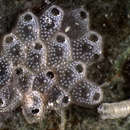pt-BR
nomes no trilho de navegação


Fenestrulina is a genus within the bryozoan order Cheilostomatida. It is the only member of the family Fenestrulinidae.[1] It has a world-wide distribution.[2]
Fenestrulina is a genus within the bryozoan order Cheilostomatida. It is the only member of the family Fenestrulinidae. It has a world-wide distribution.
Fenestrulina est un genre d'ectoproctes, bryozoaire formant des colonies encroutantes[2], de la famille des Microporellidae, classée dans l'ordre Cheilostomatida. Ces organismes contribuent, modestement, à la filtration de l'eau et au stockage du carbone. Ce genre est assez ubiquiste, trouvé des eaux tempérées à très froides (en zone polaire, antarctique notamment[3],[4]), en passant par les eaux tropicales (ex : Fenestrulina commensalis découverte au Brésil à 5-10 m de profondeur en 2008).
Certaines espèces comme Fenestrulina delicia ont été introduites hors de leur aire naturelle de répartition (introduite en Europe dans ce cas).
On en connait quelques espèces fossiles[5].
Fenestrulina est un genre d'ectoproctes, bryozoaire formant des colonies encroutantes, de la famille des Microporellidae, classée dans l'ordre Cheilostomatida. Ces organismes contribuent, modestement, à la filtration de l'eau et au stockage du carbone. Ce genre est assez ubiquiste, trouvé des eaux tempérées à très froides (en zone polaire, antarctique notamment,), en passant par les eaux tropicales (ex : Fenestrulina commensalis découverte au Brésil à 5-10 m de profondeur en 2008).
Certaines espèces comme Fenestrulina delicia ont été introduites hors de leur aire naturelle de répartition (introduite en Europe dans ce cas).
On en connait quelques espèces fossiles.